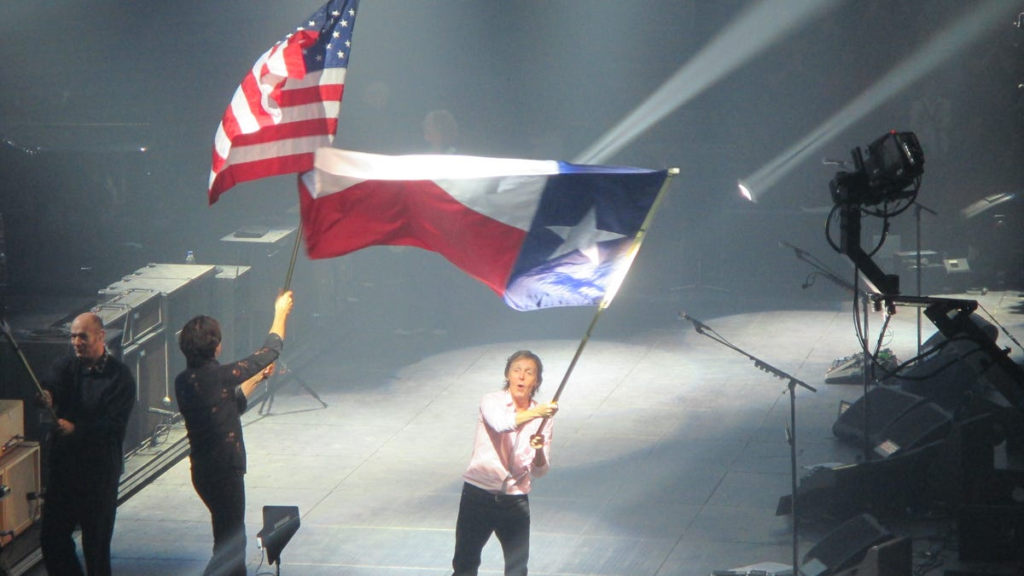Editor’s Note: Jack Becker is the editor of Caprock Chronicles and is a Librarian Emeritus from Texas Tech University. He can be reached at jack.becker@ttu.edu. Today’s article about Lubbock music history is the second of a two-part series by frequent contributor Chuck Lanehart, Lubbock attorney and award-winning Western history writer.
When the new Lubbock High School was completed on 19th Street in 1931, its auditorium became the favored local concert site for more than two decades. In 1939, Russian artist Alexander Brailowski – touted as „one of the greatest living pianists” – performed at the LHS auditorium. Brailowski’s appearance was part of a concert series presented by the South Plains Civic Music Association.
The Little Lubbock Symphony Orchestra was organized in 1946, under the direction of Bill Harrod. With 48 musicians, the orchestra presented its first concert on Oct. 22, 1946 at LHS auditorium. The Lubbock Evening Journal reported an audience of 1,500 music lovers “were amazed at the result of only a few months’ rehearsal.”
Soon, the organization was renamed the Lubbock Symphony Orchestra. The Lubbock Symphony Guild was founded in 1952 to support LSO and has since sponsored grand performances at many venues.
Racially discriminatory laws and customs prevented minorities from attending early Lubbock cultural events. But in 1950, the Lubbock Avalanche-Journal announced the famed Deep River Singers would perform at the segregated Dunbar High school auditorium, “promoting goodwill between all mankind.”
More: Caprock Chronicles: Milestones in Lubbock music, Part 1 courthouse concerts to Chautauquas
About the same time, promoter Sled Allen brought Ray Charles to Lubbock for a “Cosmopolitan Dance.” Whites, Blacks and Hispanics attended, but “There were three tight, really paranoid knots of people in that room, not getting near one another,” Sled’s son Terry recalled. “It was definitely another time.”
With the opening of the South Plains Fair Park Coliseum in 1955, rock’n’roll acts began to rival the popularity of traditional music performances. On Jan. 6, a little-known swivel-hipped “bop” singer from Memphis – Elvis Presley.
Presley opened the Coliseum. Famously, among the audience was 18-year-old Buddy Holly, who was inspired to abandon bluegrass and country music in favor of rockabilly. The venue continued to host musicians headlining the South Plains Fair each year.
The following year, Lubbock’s Municipal Auditorium/Coliseum complex was completed. On July 3, 1956, actress and singer Jane Powell opened the 8,300-seat Coliseum, which continued to present major performers for decades. A memorable Elvis concert took place in 1976, a year before his untimely death. Other special Coliseum events: Iron Butterfly, John Denver, the Beach Boys and Bon Jovi.
More: Demolition update: Lubbock coliseum’s maroon dome razed
The adjoining 2,800-seat Municipal Auditorium hosted smaller concerts, including orchestras, operas and popular artists such as Tony Bennett, Jackson Browne and Bonnie Raitt. The aging Auditorium and Coliseum were razed in 2019.
Community Concerts Association, formed in 1960, used high school auditoriums to present inexpensive entertainment. Also in the 1960s, Francisco Hernandez directed the Lubbock Municipal Orchestra in free concerts at Lubbock’s Garden and Arts Center. In 1969, the Lubbock Municipal Band was organized. Directed by Dean Killion, the band performed concerts under the stars in city parks, with patrons bringing their own lawn chairs. The Lubbock Civic Chorale was established in 1976 and continues to offer quality concerts, sometimes teaming with Texas Tech choirs and orchestras.
Joe Ely’s three “Tornado Jams,” outdoor music festivals between 1980-1982, drew thousands to Buddy Holly Park to hear local and national artists, including Linda Ronstadt and Joan Jett.
On the Texas Tech campus, the state-of-the-art multi-purpose United Spirit Arena was completed in 1999. On Feb. 8, 2000, the opening act was superstar rocker Elton John, who performed solo for a capacity audience of 15,300. The largest indoor venue in Lubbock, the arena has attracted some of the biggest names in show business, including Kiss, George Strait, Fleetwood Mac and Cher. In 2014, Paul McCartney—with a nod to Buddy Holly—packed the arena for an inspired three-hour performance.
More: McCartney gives of himself in lengthy, at times personal, concert Thursday
In 2009, the venerable 60,000-seat Jones AT&T stadium hosted a mega-concert showcasing Bob Dylan, Willie Nelson and John Mellencamp.
Since Buddy Holly Hall opened in 2021, the Lubbock Symphony Guild has presented world-class orchestral music and musicians, including Yo-Yo Ma. Other notable artists who have graced the 2,300-seat main performance hall include Foreigner, Dwight Yoakam, the Beach Boys and Chicago.
More: A tour of Lubbock’s new Buddy Holly Hall
A couple of other long-gone venues, the Cotton Club and Stubb’s, are noteworthy for their contributions to Lubbock’s reputation for nurturing little-known musical talent. Between 1938-1980, the 1600-seat capacity Cotton Club on Slaton Highway hosted seemingly every local and touring country act and early performances by Little Richard and Elvis.
As Lubbock was a “dry” town, the Cotton Club and similar honky-tonks were “bring your own bottle” establishments until 1971, when Texas Governor Preston Smith of Lubbock signed legislation legalizing the sale of “liquor by the drink” in taverns statewide. Suddenly, bars popped up like mushrooms in Lubbock, and saloonkeepers hired bands and entertainers to attract customers. Musician Lloyd Maines described the next few years as a “feeding frenzy,” when almost “every club had music seven nights a week.”
In the 1970s, the 40-seat Stubb’s BBQ on East Broadway lent its tiny stage to Stevie Ray Vaughn, Jesse “Guitar” Taylor, Joe Ely, Jimmie Dale Gilmore, Butch Hancock, the Maines Brothers and a host of blues greats long before they were famous.
Caprock Chronicles explores milestones in Lubbock music, from high schools to Buddy Holly – Lubbock Avalanche-Journal
